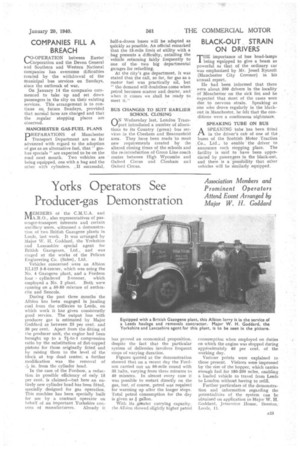Yorks Operators See Producer-gas Demonstration
Page 35

If you've noticed an error in this article please click here to report it so we can fix it.
hAEMBERS of the C.M.U.A. and LY1A.R.0., also representatives of passenger-transport interests and certain ancillary users, witnessed a demonstration of two British Gazogene plants in Leeds, last week. It was arranged by Major \V. H. Goddard, the Yorkshire and Lancashire special agent for British Gazogenes, Ltd., and was staged at the works of the Pelican Engineering Co. (Sales), Ltd.
Vehicles concerned were an Albion KL127 5-6-tonner, which was using the No. 4 Gazogene plant, and a Fordson four cylindered 2-tonner, which employed a No. 2 plant. Both were running on a 50-50 mixture of anthracite and Suncole.
During the past three months the Albion has been engaged in hauling coal from the collieries to Leeds, on which work it has given consistently good service. The output loss with producer gas is estimated by Major Goddard as between 25 per cent. and 30 per cent. Apart from the •fitting of the producer unit, the engine had been brought up to a 7*-to-1 compression ratio by the substitution of fiat-topped pistons for those originally fitted and by raising them to the level of the block at top dead centre; a further modification was the removal of in. from the cylinder head.
In the case of the Fordson, a reduction in possible efficiency of only 15 per cent, is claimed—hut here an entirely new cylinder head has been fitted, specially designed for gas operation. This machine has been specially built for use by a contract operator on behalf of an important Yorkshire con cern of manufacturers. Already it has proved an economical proposition, despite the fact that the particular system of deliveries involves frequent stops of varying duration, Figures quoted at the demonstration showed that on a recent day the Fordson carried out an 80-mile round with 35 halts, varying from three minutes to 40 minutes. In almost every case it was possible to restart directly on the gas, but, of course, petrol was required for warming up after the longer stops. Total petrol consumption for the day is given as gallon.
With its greater carrying capacity, the Albion showed slightly higher petrol consumption when employed on duties on which the engine was stopped during approximately 40 per cent, of the working day.
Various points were explained to those present. Visitors were impressed by the size of the hopper, which carries enough fuel for 180-200 miles, enabling a loaded vehicle to travel from Leeds to London without having to refill.
Further particulars of the demonstration and information regarding the potentialities of the system can be obtained on application to Major W. H. Goddard, jessamine House, Beeston, Leeds, IL




























































